High-performing organizations create positive employee experiences. This is not a controversial statement, but it provides no helpful information as to what “high performance” looks like or how an organization might achieve it. Using the Qualtrics Employee Engagement benchmark database – a repository of over 27 million employee responses from over 900 organizations – the Qualtrics team of data scientists have uncovered empirical insights into specific patterns of employee experiences that differentiate high performing organizations from the global average¹.
The Four Differentiated Employee Experiences in High Performing Organizations
Using the Qualtrics benchmark dataset from 2021 to 2023, the data science team identified 49 “High Performing” (HP) organizations, based on both financial and employee experience indicators. Across item-level metrics, there are clear patterns of employee experience that distinguish HP organizations from the average of all organizations in the Qualtrics customer database².
This analysis showed that organizations who outperform both financially and on EX metrics do more than just provide functional workplaces — employees report more positive sentiment towards strategic alignment with a future vision, trust in leadership, personal agency, and resilience as they adapt to change.
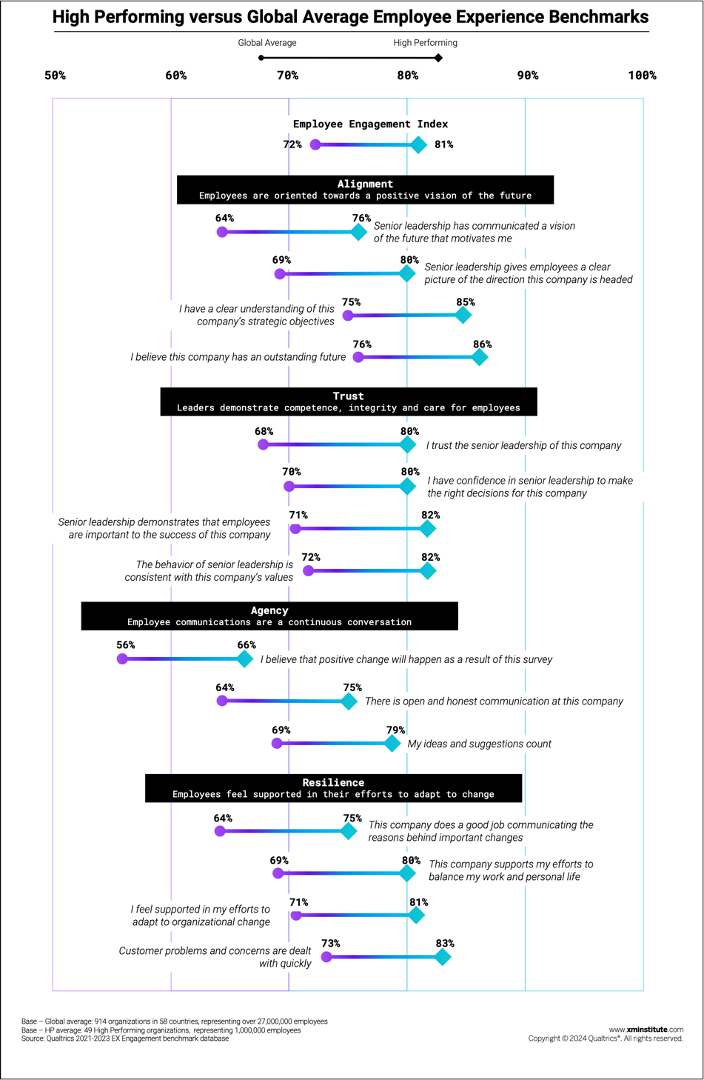
By comparing HP organizations to the global average in this extensive database, EX metrics that show a gap of 10 points or more reveal clear thematic trends that distinguish market leaders from the average. These four themes provide empirical support for the employee experiences that act as the strongest strategic levers for organizational performance.
Alignment: Employees are oriented towards a positive vision of the future
Even during times of disruption, a workforce that is empowered with a clear strategic vision has the ability to rapidly adapt and maintain momentum towards organizational goals. This is a key theme among High Performing organizations, with their employees reporting that senior leaders provide a clear picture of the direction the company is headed towards (11 pts higher), that this vision of the future motivates them (12 pts higher) and they believe that their organization has an outstanding future (10pts higher). Translating this vision into momentum, employees in HP organizations are more positive about having a clear understanding of the company’s strategic objectives (10pts higher).
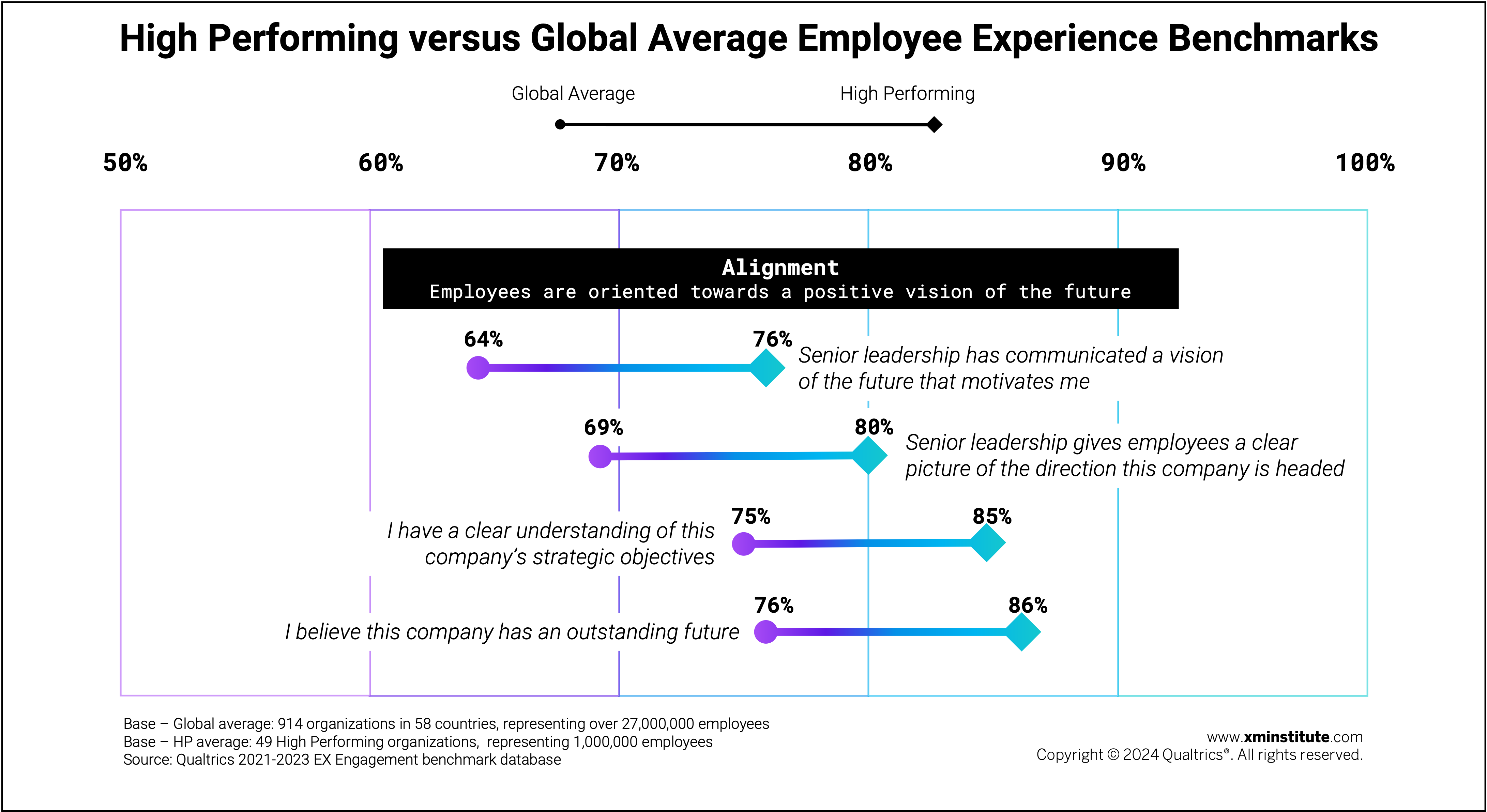
Here are some recommendations for improving employee alignment with your organization’s strategic direction:
- Over-communicate in times of uncertainty. When things are in a state of flux, it is difficult to provide clear and transparent communication. But silence is worse. Bring employees into the decision making processes where possible, especially when you don’t have the answers.
- Connect employees to the future. Engaged employees see themselves as part of the organization’s future success. Offer career planning, job crafting that makes clear connections between changing goals and people’s roles, and ensure employee ideas are valued as a source of innovation.
- Invest in robust & fair performance management. High performing organizations continuously improve and enhance the efficiency of their performance management systems, as this facilitates the conversion of a vision and motivation into impactful actions for every employee. While these vary across each organization, they connect goal setting, performance reviews, growth & development, rewards and incentives.
Trust: Leaders demonstrate competence, integrity and care for employees
Organizational performance is highly dependent on the level of trust that leaders are able to build and maintain with their employees and customers. The data from high performing organizations reinforces this, as these employees rate their trust in senior leaders 12 points higher than the global average. Trust is achieved when leaders are perceived as competent, consistently act in alignment with organizational values, and demonstrate care for employees. Compared to the global average, employees in high performing organizations rate these experiences much more positively — on average, confidence in senior leaders to make the right decisions for the company is 10 points higher, agreement that the behavior of senior leadership is consistent with [organizational] values is 10 points higher, and feeling that senior leaders demonstrate that employees are important to the success of the company is 11 points higher than the global average.
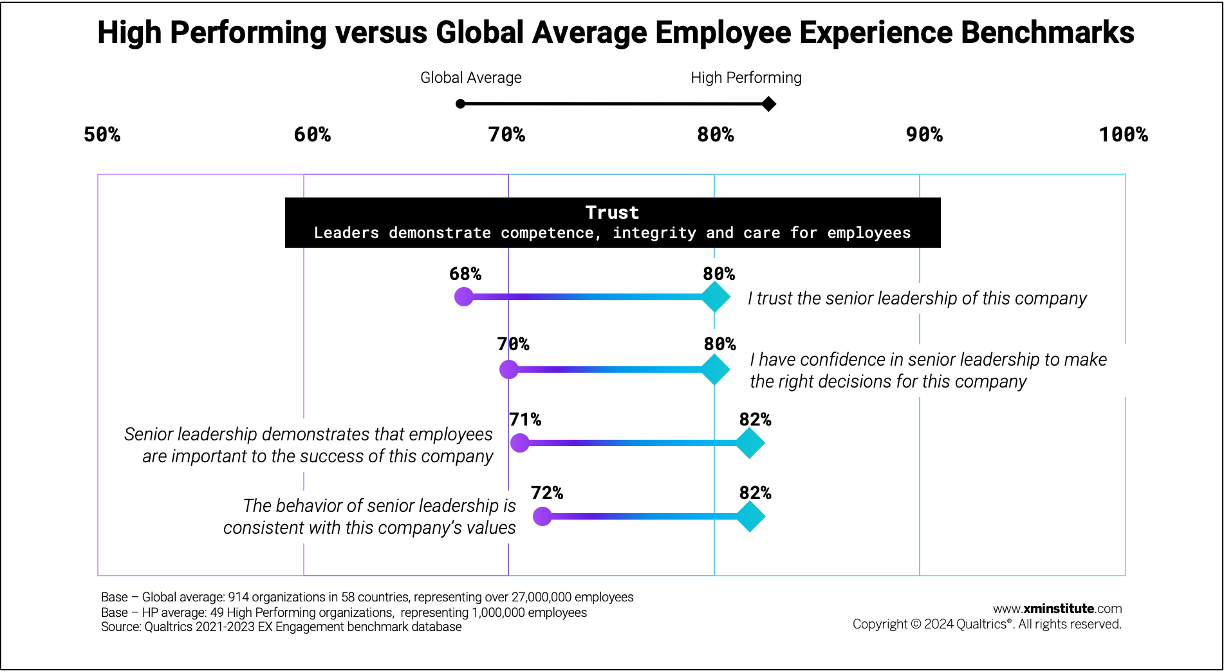
Here are some recommendations for strengthening employee trust in senior leadership in your organization:
- Describe values as verbs. Defining and communicating the organization’s values is important, but only take root when they are tied to behaviors. Communicate your organizational values with examples of how they are demonstrated through daily actions so that employees know what it looks like when they see it.
- Leaders seek feedback. When leaders receive feedback on how their behavior is perceived, they can make adjustments and continuously grow. But it is highly unlikely that employees will spontaneously provide constructive feedback to their superiors – leaders must ask for feedback, genuinely listen, and act on it when possible. This might make leaders feel vulnerable, but is a necessary first step to demonstrate trust in employees so that it may be returned.
- Anchor change to core principles. While the strategic direction of the organization may change over time, the core values and principles should remain steadfast. Ensure these are widely understood, that all employees (especially leaders) are consistently rewarded for values-driven behaviors, and that key decisions are validated against these commitments before being locked in.
- Redesign structures to facilitate trust. There are some traditional organizational practices, such as stack-ranked performance ratings, that can unintentionally put employees in competition with each other, reduce collaboration, creativity, and team effectiveness – all of which are essential for organizational cohesion and performance. Consider new ways of working that enhance employees’ capacity to contribute to others’ success, foster growth mindsets so failures are learning experiences, and recognize contributions to group-level performance.
Agency: Employee communications are a continuous conversation
A common feature of a dynamic, high performing organizational culture is a focus on communication excellence, characterized by the mutual exchange of information and ideas. Our research found that employees in high performing organizations rated their organization’s communication as open and honest 11 points higher than the global average – an indicator of how transparent a corporate culture really is. The connection between open & honest communication and higher organizational performance is a reminder of how crucial this cultural feature is for psychological safety. Employees must be able to not only perceive honestly in the communications coming their way, but also feel that when they speak up their ideas and suggestions count and positive change will happen in response to survey feedback, both of which are rated meaningfully higher among employees at high performing organizations (+10 pts). Employees in high performing organizations not only want to be heard, but also believe that when they do, these efforts will have an impact and fuel organizational improvements. This demonstrates a proactive approach to employee engagement, in which leaders’ commitment to action on survey results is both anticipated and observable.
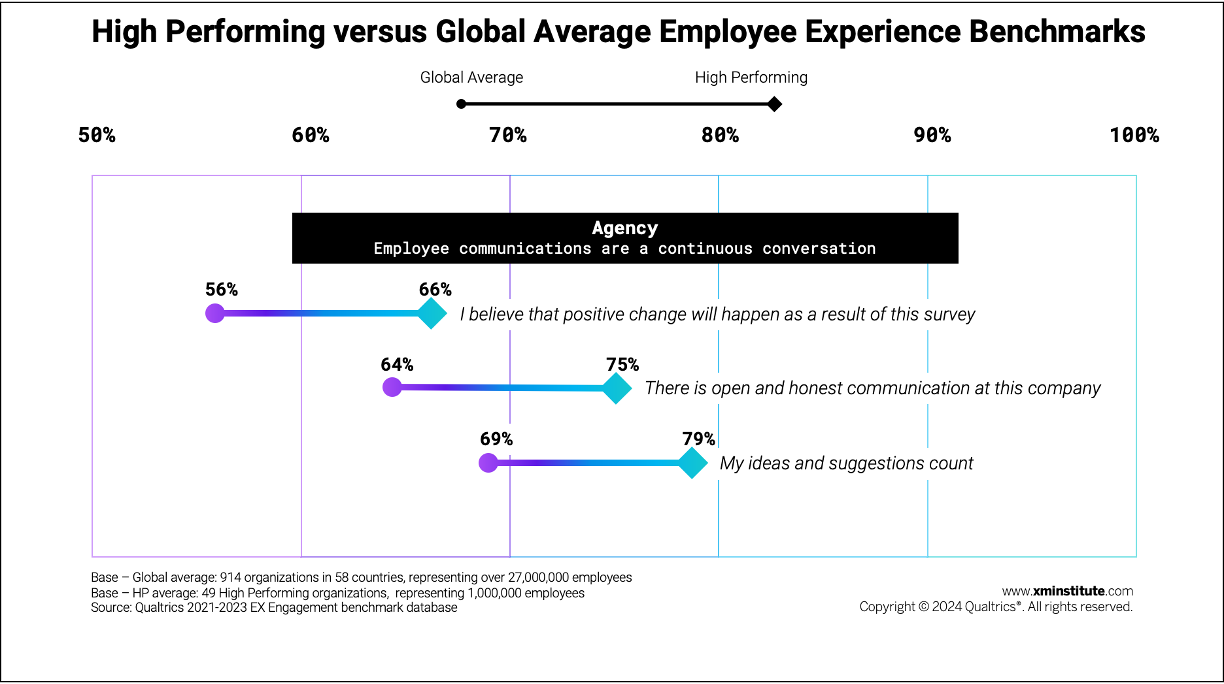
Here are some recommendations for enhancing employee agency and activate high-value continuous conversations in your organization:
- Protect employee privacy. To feel safe sharing their feedback and ideas, employees must feel these will be used appropriately. This requires clear principles on the use of employee data and policies that protect them from retaliation.
- Provide various listening opportunities. Ensure employees are able to communicate with leaders and provide feedback on their experiences as they happen. Employees in high performing organizations don’t have to wait for the annual engagement survey – they have access to multiple communication channels that are always open.
- Remember that asking for feedback is a commitment to action. Employees expect that the time they invest in sharing their perspectives will be put to good use. Ensure that every request for feedback has clear accountability for action before requesting feedback and that every listening project has clear ownership.
- Communicate the impact of employee feedback. Often, EX insights are used to inform important decisions, but employees cannot see the connection. Don’t assume employees know the impact of their feedback – tell them at least three times, across three or more channels.
Resilience: Employees are supported in their efforts to adapt to change
As agility becomes a core differentiator of organizational performance, making the transition from top-down decision making towards greater employee empowerment is essential. In high performing organizations, employees are 10 points more likely to feel supported in [their] efforts to adapt to organizational change versus the global average, and rate their organization doing a good job of communicating the reasons behind important changes 11 points higher. They also believe that customer problems and concerns are dealt with quickly 10 points higher than the global average – the swift resolution of customer issues is an indicator of efficient work systems and processes, which is most often the product of employees’ active involvement in continuous improvement efforts. Employee empowerment includes having the flexibility needed to deliver the best outcomes; employees in high performing organizations feel supported in their efforts to balance work and personal life 11 points more positively than the global average. These insights show that while every organization is facing the accelerating pace of disruption, it is those who focus on both effectively supporting employees through change and enabling them to adapt who are emerging in a position of strength.
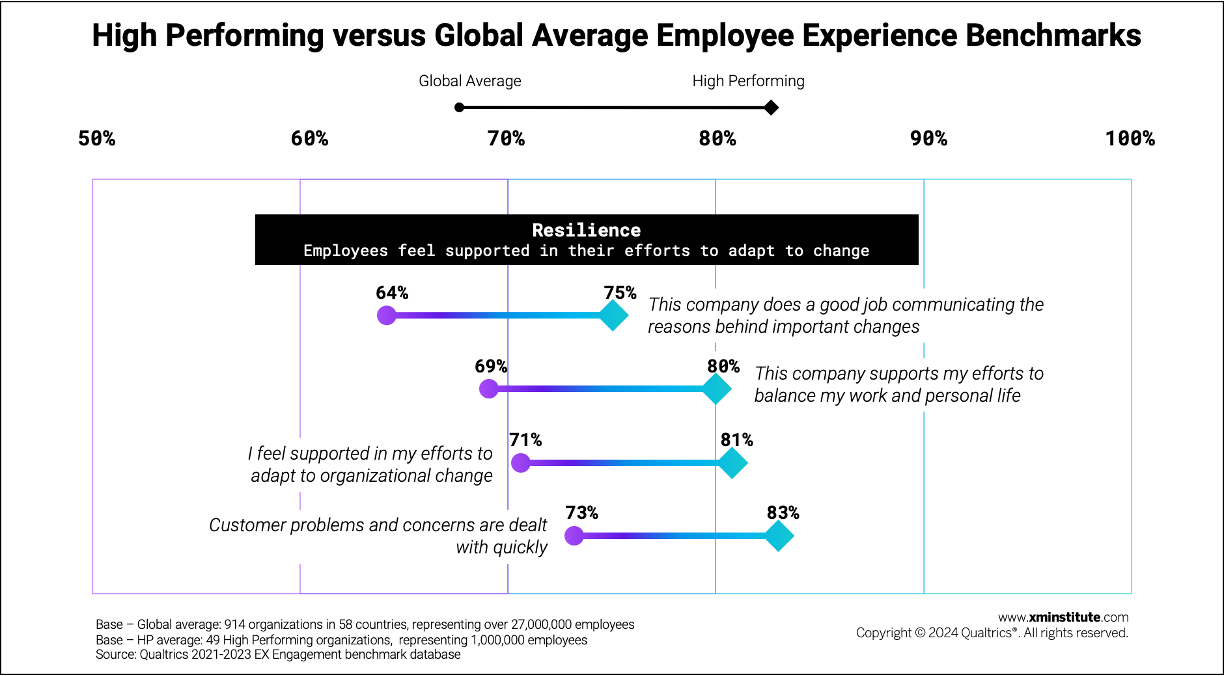
Here are some recommendations for empowering and supporting employees in your organization so they can effectively adapt to change:
- Over-communicate the impact of change. Change is inevitable, but high performing organizations are proactive in supporting their employees to adapt. This goes beyond explaining the rationale; cascade capability to ensure the conversations happen at the team level and people know how this impacts their jobs.
- Empower employees to resolve customer issues quickly. Wherever possible, move away from top-down decision making practices, and instead provide employees with the autonomy and authority they need to resolve customer problems promptly. But remember, increasing autonomy only leads to excellent results when adequate training and support is already in place, so these must go hand-in-hand.
- Activate flexible working as a strategic lever. Organizations that provide a variety of flexible work options, as well as the autonomy for teams to customize the way they work, will be rewarded with a resilient and productive workforce that drives sustainable performance. High performing organizations don’t see flexible working as a perk, they’re intentional about enabling leaders with the options and skills needed to flexibly manage their teams in ways that generate the best outcomes.
About this study
The database used for this study is the same one that Qualtrics uses to calculate their employee experience benchmarks, calculated by employee responses to engagement survey requests from their employers. The library of over 300 Employee Engagement items has benchmarks at the country, industry and region level¹. This study unpacks the patterns found in the new global “high performance” (HP) benchmark derived from a subset of organizations that achieve high performance on objective financial outcomes, combined with top quartile employee experience metrics². This method enables leaders to compare their data against other organizations who are excelling in both financial and employee experience performance, providing an intersectional perspective beyond industry averages or percentiles.
The bottom line: There are clear employee experiences that differentiate high performing organizations.
- The Qualtrics Employee Experience Engagement benchmark database is made up of 914 customer organizations from 500 to 500,000 employees in size, over 27 million employee responses from 58 countries and a diverse set of industries. 60 standardized EX questions compose the High Performing benchmark. For more information on how these benchmarks are calculated, take a look at the Qualtrics benchmark overview for the EX25 (Engagement & Pulse) Solution. The full Qualtrics benchmark datasets can be accessed through the Qualtrics EX platform.
- 49 High Performing (HP) organizations and more than 1.5 million employee responses were identified on the basis of financial and EX indicators. EX Indicator: Using the standardized items from the Qualtrics EX certified library, percent favorable scores were calculated for each question and organization to calculate an overall employee experience metric to identify those in the top quartile. Financial Index: Financial health indicators sourced from CapiQ, a financial research platform that provides data and analytics on companies and markets. HP organizations outperformed on the three year average on four or more of the following financial indicators are included in the HP benchmark: total revenue 1yr growth, 1yr return on assets, 1yr return on equity, 1yr return on total capital, 1 yr return on capital, and gross profit 1 yr growth. These 49 organizations range from 900 to 500,000 employees in size, and include the following industries: Communication Services, Financials, Consumer Staples, Materials, IT, Real Estate, Health Care, Industrials, and Consumer Discretionary. Respondents are from 34 countries including but not limited to: Australia, Brazil, China, France, Germany, Japan, South Korea, UK, and US.





